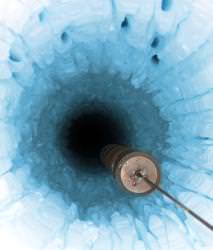If you think you need to install a telescope on a mountaintop, or even above the surface of the Earth, think again. A new telescope currently being installed near the South Pole has detectors more than 2 kilometres under the surface of the Antarctic ice cap. For the neutrinos it’s searching for, that much ice is the same as nothing at all.
Neutrinos are illusive particles generated by the fusion reactions in the Sun and other cosmic events. They barely interact with normally matter, passing right through like it’s complete vacuum. Only in the rarest occasions will a neutrino collide directly normal matter, releasing a torrent of subparticles and radiation.
Once completed, the IceCube observatory will consist of detectors arranged in a 1 kilometre cubic array frozen underneath the surface of the Antarctic ice cap. Construction is currently into its 3rd year, with more than 20 institutions participating. The final instrument will consist of more than 70 strings, each containing more than 60 optical detectors frozen into the ice.
When operational, IceCube will be able to detect neutrinos from the Sun, as well as some of the most catastrophic events in the Universe, such as a supernova or black hole. The neutrinos will interact with particles of ice within the array, and produce a cascade of particles that will produce a flash of light captured by the optical detectors.
The full construction is going to take another 3-4 years, but the array is already operational, and gathering scientific results.
Original Source: University of Delaware News Release


I remember reading a book about the neutrinos. Does seem odd when you look at the title about the post, until you read it.
Makes total sense, and should provide some great knowledge to key events in the universes time.